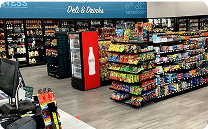In This article
Introduction: The Importance of Customer Experience in Retail
Delivering a superior retail customer experience is essential to your business’s success in 2025. As consumer expectations evolve, your brand must differentiate itself beyond price and product. Customer satisfaction now hinges on speed, convenience, personalization, and emotional connection. A robust customer experience strategy drives conversions and cultivates participation in retail loyalty programs that keep shoppers returning.
Omnichannel Integration: Creating a Seamless Shopping Journey
Omnichannel retail is at the core of the modern retail customer experience. Consumers want and expect to interact cohesively and consistently with brands across multiple touchpoints—online, in-store, mobile apps, and social media. According to IBM, retailers using omnichannel strategies see 30% higher lifetime customer value than those that don’t.
Whether customers browse online and purchase in-store or begin their research on a mobile app and complete their purchase at a kiosk, you must ensure frictionless transitions across all channels. Here are some key elements of effective omnichannel integration.
- Synchronize inventory across platforms.
- Implement “buy online, pick up in store” (“BOPIS”) options.
- Ensure consistent pricing and promotions.
- Offer seamless customer service across digital and physical environments.
Personalization: Making the Experience Truly Individual
Personalized retail experiences elevate engagement by tailoring content, offers, and communication to each shopper based on their preferences. InMoment reports that 75% of customers are more likely to buy from a retailer that recognizes them by name and recommends options based on past behavior.
You can create moments that make shoppers feel seen and valued using customer data such as purchase histories and browsing behaviors. Here are some effective personalization tactics.
- AI-driven product recommendations.
- Dynamic website content that reflects user behaviors.
- Personalized email campaigns and app notifications.
- Loyalty rewards tailored to align with past purchases.
Technological Enhancements: AI, AR, and VR in Retail CX
Technology is transforming the retail customer experience in multiple ways. Artificial intelligence (AI), augmented reality (AR), and virtual reality (VR) can enable retailers to innovate the path to purchase and bridge the gap between physical and digital retail.
Retailers that adopt these technologies deliver faster, more engaging, and more interactive customer experiences that result in higher conversion rates and satisfaction scores. Examples of cutting-edge technology use in retail include the following.
- AI chatbots for instant customer service.
- AR-enabled fitting rooms for apparel and cosmetics.
- VR store walkthroughs for immersive brand engagement.
- Smart shelves and Internet of Things (IoT) sensors for real-time inventory updates.
Customer Service Excellence: Human Interaction Still Matters
Despite digital advances, the human touch remains essential to the retail customer experience. This is even more true as customers seek help navigating new, updated shopping technologies.
Zappos, often cited as a leading and innovative online retailer, built a billion-dollar brand on service excellence by investing in both modern technologies and customer-centric culture and support. Your customer-facing staff must be well-trained, empathetic, and empowered to resolve issues quickly. Other Key elements of excellent customer service include the following.
- Consistent, easily navigable multichannel support that integrates in-store, phone, online, live chat, and social media options.
- Staff training on emotional intelligence, product knowledge, and problem resolution/escalation.
- Fast and flexible return/exchange policies.
- Prompt, helpful post-purchase follow-up communication
Experiential Retail: Creating Memorable In-Store Moments
Experiential retail is how retailers are shifting from operating purely transactional spaces to delivering environments that entertain, educate, and immerse customers. The ability to offer customers more engaging and emotionally resonant experiences is transforming brick-and-mortar retail facilities of all types.
Nike, Apple, and Lululemon have excelled in experiential retail, using stores as brand theaters that attract foot traffic and deepen emotional loyalty. Some proven tactics you can use to enhance the in-store experience for your customers include the following.
- Live product demos or workshops.
- In-store events and influencer appearances.
- Interactive displays and digital installations.
- Themed store designs with sensory experiences.
Feedback Mechanisms: Listening and Responding to the Customer
Continuous improvement requires feedback. You must actively collect, analyze, and act on customer insights to refine your customer experience strategy. RetailCustomerExperience.com suggests using the popular Net Promoter Score (NPS) as a core metric to track satisfaction and long-term loyalty. Here are some other effective feedback strategies.
- In-store and digital surveys.
- Review and sentiment analysis on social platforms.
- Mystery shopping and secret shopper programs.
- Reward loyalty program members who provide feedback.
Brand Consistency: Strengthening Retail Identity
Whether customers interact online or in person, retail branding must feel cohesive across visuals, messaging, tone, and service. Consistency drives customer trust in your brand. A consistent brand builds trust and reinforces customer expectations, making every interaction more predictable and enjoyable. Here are some best practices for brand consistency.
- Unified visual identity, including logos, colors, and typography.
- A constant “brand voice” that aligns with customer and community values.
- Standardized employee uniforms and store layout.
- Clear, consistent brand guidelines for franchisees.
Community Engagement: Building Emotional Loyalty
Every effectively engaging retail customer experience involves an emotional connection. You can transform customers into advocates by creating a sense of belonging and active participation in your store’s community. InMoment research has found that customers with emotional connections to a brand have a 306% higher lifetime value. Some paths to effective community building include the following.
- Hosting community events or partnerships.
- Supporting social causes relevant to your audience.
- Encouraging user-generated content and reviews.
- Engaging on social media through interactive campaigns.
Conclusion: Elevating the Retail Experience
The future of the successful retail customer experience is being built on the foundations of integration, innovation, and emotional intelligence. Brands that embrace omnichannel retail, invest in personalized retail experiences, and maintain consistent retail branding will enjoy more loyalty, retention, and profitability. You can turn even casual shoppers into enthusiastic, long-term advocates by making elevating your customers’ experiences a strategic priority. To learn how DTiQ enhances customer experience, visit our website.
Frequently Asked Questions
What is retail customer experience?
It encompasses every customer interaction with a retail brand, across physical and digital touchpoints, from browsing and purchasing to post-sale support.
How does omnichannel retail improve customer satisfaction?
It allows seamless transitions between channels, offering more convenience, flexibility, and consistency throughout the buying journey.
Why is personalized retail important?
It shows customers they are understood and valued, increasing engagement, satisfaction, and conversion rates.
How can technology enhance the retail experience?
Technologies like AI, AR, and VR streamline processes, provide immersive experiences, and enable real-time responsiveness.
What role does community engagement play in CX?
It fosters emotional loyalty, encourages advocacy, and helps brands connect with customers on a deeper, more personal level.


























